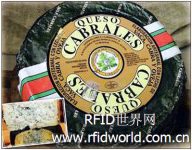
RFID tags used to track rare Spanish cheeses
[ad_1]
European researchers are now testing whether RFID technology can be used to electronically record the production process of Spanish cheese Queso Cabrales. This project is sponsored by ESTIIC (a subsidiary of the European Union) and the state government of North Rhine-Westphalia, and is implemented by the Department of Logistics of Dortmund University.
Queso Cabrales is a kind of leaf-packed, rich-flavored blue cheese. This cheese is processed from cow’s milk and goat’s milk and fermented and matured in a cave. According to Jochen Schneider, a representative of the logistics department of Dortmund University, this type of cheese is produced in very small quantities, and only some private farms in Spain produce it. “There are no modern industrial processes in the production process,” Schneider said. “Some caves don’t even have electricity.”

Queso Cabrales
In addition to the researchers, a local dairy laboratory in Spain responsible for cheese quality and safety also participated in this project. “We want to record the production history of each piece of cheese,” Schneide explained. In this way, the freshness of cheese sold for customers is guaranteed, and audit records can also be found in the event of returns or food safety issues.
The project started in July 2006 and is expected to end in November this year. The frequency of the tag is 125 kHz, and the HITAG S chip of NXP Semiconductors is embedded. The tag’s memory is 2 kilobytes, which is used to store information about each production step, including the farmer’s identity number and the ingredients of the cheese.
Use the software developed by FLog to program the unique EPC serial number for the label. Schneider said the 125 kHz frequency was chosen to avoid multiple tags being read at the same time. “We want to track every piece of cheese,” he said, “know the tags read at any time.” In each production step, farm workers use handheld readers to collect tag data, such as when the cheese was first injected into the model .
Queso Cabrales cheese began to be labeled in the first stage of production, which was the biggest challenge encountered by the project. Shneider said, because at that time, the cheese was still in a viscous liquid state. “It is impossible to use the usual tags,” he said. “Therefore, we used a coin-sized RFID button tag with a diameter of 20 mm and a thickness of 2 mm.”
When the cheese is matured and shipped to the retail store, the RFID tag is read again and removed. “Tag data is stored in a central database, and permissions are open to everyone,” Schneider said. “This is specially designed for the relevant departments of the European Union. Customers can also inquire whether the cheese purchased is genuine and its production records.”
This project is expected to use several hundred tags.
[ad_2]



